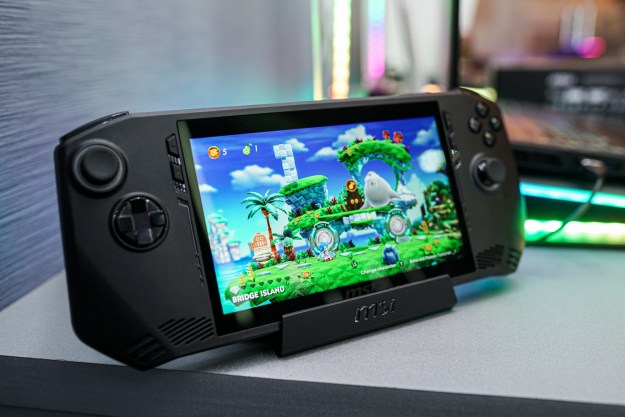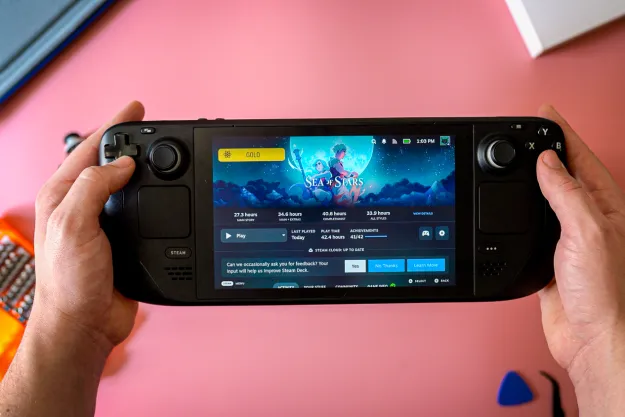In early April, I reviewed the EK 275 Conquest. It’s a gaming PC built with custom liquid cooling, which brought forth years of misconceptions, bad advice, and dated ideas about custom liquid cooling and what it could do to the hardware. What if there’s a leak? What if a fitting isn’t put on correctly? What if I need to take the loop apart to troubleshoot a problem?
I quickly learned that I had nothing to worry about.
The Conquest was remarkably easy to get set up, and within a few hours after using it, I had a shopping cart filled with parts for a custom loop of my own. It’s a hobby that has come a long way for newcomers, so I sat down with Attila Gober, senior product marketing manager at EK, to understand the common misconceptions about liquid cooling, how the industry has made it more accessible, and how the process doesn’t have to be scary.
Misconceptions about custom liquid cooling
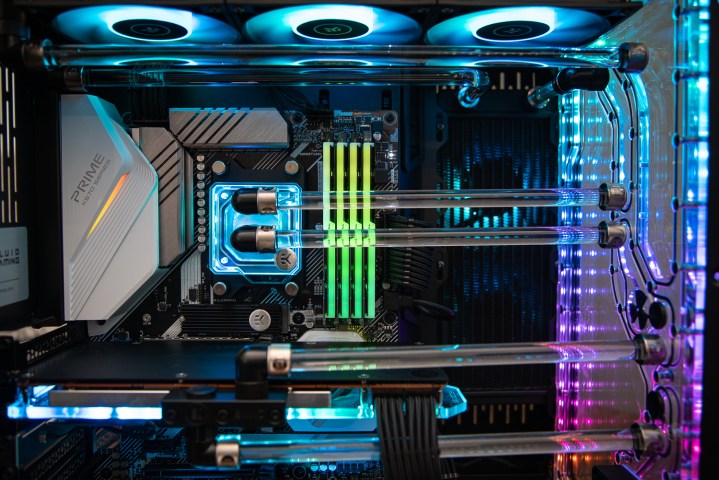
There are a lot of misconceptions about custom liquid cooling, and it makes sense. You’re putting water next to components that cost thousands of dollars, which is prime for speculation and assumptions. According to Gober, most of those misconceptions are either wrong or severely misguided.
Let’s start with water and the idea that it could ruin your components. Liquid-cooled PCs don’t, or at least shouldn’t, use just water. Companies like EK and Mayhems sell dedicated coolants, which are comprised of multiple chemicals that prevent algae growth and rust, among other protections. Unlike straight water, they aren’t electrically conductive — at least initially.
“All of the coolants which are made are non-conductive. When you put them into your loop, that’s when the liquid becomes conductive,” Gober said. It’s the process of the liquid rubbing against metal in your loop that makes it conductive, so the only risk comes from neglected leaks days or even weeks after the loop has been running. Gober says leaks and minor spills beforehand aren’t a big cause for concern. “Leave it to dry, leave it for one day or maybe even more, and you have a 99% chance that everything will be fine.”
The other major misconception is maintenance. Gober says this is the “main misconception” he’s encountered, because custom liquid cooling doesn’t require much maintenance at all, assuming your loop is working correctly. EK recommends replacing your coolant once per year. That’s less than most air-cooled PCs.
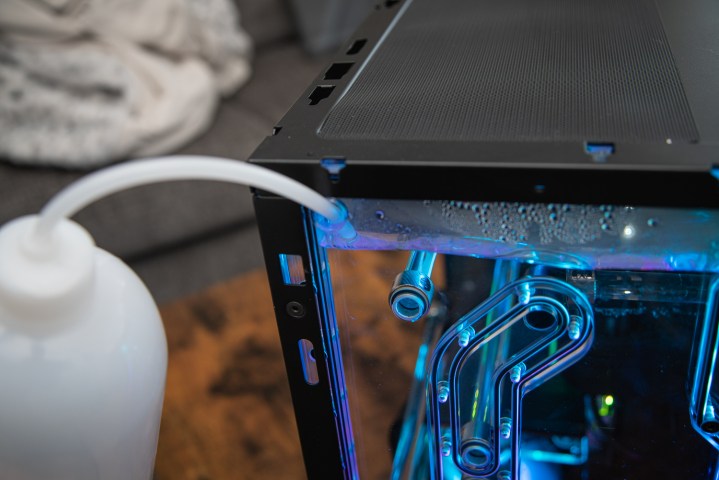
Gober had a personal experience to share on this front: “Even when I had a fully air-cooled PC with 12 Noctua fans, I was cleaning my filters, dusting my PC every few months.”
That’s not to say the custom liquid cooling is easy. Although basic maintenance is much less than what new builders may assume, a custom loop makes it more difficult to get at your hardware in case there’s an issue. “This is why it’s important to always test the hardware prior to installing liquid cooling,” Gober said.
Making the process easier
Custom liquid cooling has been around for decades, but misconceptions aren’t the only thing that have held would-be custom liquid coolers back. It’s been a slow process, but the liquid cooling industry has been pushing toward making the process easier and more inviting to newcomers.

“EK and the whole industry has been working toward this, that it is easier for everyone to get into custom loop liquid cooling without all of the fears and mishaps,” said Gober. An example of that is EK’s Leak Tester, which is a small tool that can point find leaks in your loop before you put liquid in. EK isn’t alone here, either, with companies like PrimoChill selling pressure meters to detect leaks.
Avoiding the hard sell, Gober provided a free DIY alternative: Simply blowing through the loop as custom liquid coolers have done for years.
The number of custom liquid cooling products has grown significantly, too, allowing for more diverse hardware and easier installation. Lian Li’s PC-011 Dynamic case — among the best PC cases you can buy — has dedicated distribution plates available, for example. “Even changing your coolant nowadays is much safer because you have disruption plates, more ports for draining,” Gober said.

To see how far custom liquid cooling has come, it’s good to look back. Gober shared that his first introduction to liquid cooling involved using Bluestone, a copper sulfate mixture used as a disinfectant. Now, not only are dedicated coolants available to purchase, but they’re backed by support.
“The way you got this important information was forums and stuff like that, but nowadays, manufacturers have like, ‘buy this and if something is wrong, then you have our support,’” he said.
The work isn’t over yet, either. EK is actually in the process of launching its Matrix 7 line of products, which will be a standard for custom liquid cooling that should make it easy to pair your liquid cooling hardware with your PC hardware.
Room for error

Gober shared some encouragement for new builders who may be scared off by custom liquid cooling. He said that “not even new builders, actually veterans” make the lion’s share of mistakes, which usually comes down to not reading the manual or doing your due diligence during the build process.
He pointed out an example of a builder installing a GPU block separate from a liquid loop and complaining about overheating, as well as users installing tubes in a way that liquid wouldn’t circulate throughout the block. “These are the basic things, like, if you don’t understand, you have to read the manual.”
Custom liquid cooling isn’t easy, and it’s far from simple. But enthusiasts who are interested in the hobby have a lot of room and resources to correct errors before they’re detrimental. In the case of a leak, for example, Gober says that they mainly come up when the builder didn’t pay enough attention. “Each time I had a leak, it was my fault because I didn’t check”
Not impossible
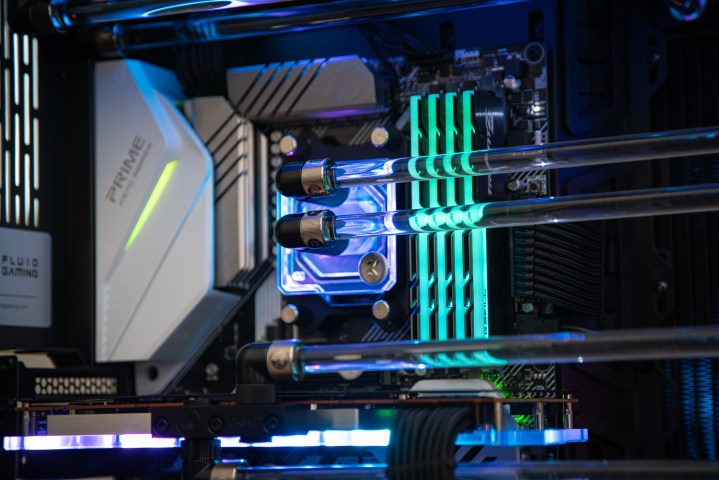
Custom liquid cooling isn’t for everyone, and Gober recognized that. It’s for professionals that want to squeeze the most out of their hardware, as well as enthusiasts that just want some glam for Instagram. “I like to compare the car scene to the liquid cooling scene,” Gober said. “Do you really have to have red and green fittings? No, you don’t. Do you have to have big wheels on your car? No, no, no. But someone may want a nice car and say to the world, ‘this is my car.'”
If you’re a beginner and want to get into the world of custom liquid cooling, this is just the first step. There’s a lot of research, reading, and questions involved. But it’s not as daunting of a task as it once was, and that’s great for PC builders that want to make their build stand out.
Editors' Recommendations
- No, Intel isn’t blaming motherboard makers for instability issues
- You’ll never guess what this YouTuber built into a PC this time
- I keep my PC on the floor, and you can’t convince me otherwise
- This might be why AMD’s FSR 3 isn’t picking up momentum
- AMD’s FSR 3 compromise just isn’t working


